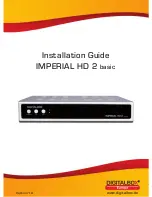
8
DMAN-xxxx-xx
www.omnexcontrols.com
call toll free: 1-800-663-8806
Position Status Enable/Disable
(option 2), in Figure 1, allows you to configure the status fields as shown in Figure 4
The
Toggle Paddle/Joystick Axis Neut/Pos/Neg Position Status
(option 1), in Figure 4, toggles the meaning of the
neutral, positive and negative position status fields in the BJ and EJ messages. If they are enabled then these fields are
set according to the positions of the joysticks, paddles or dials.
For example, if a joystick is in its neutral position then the corresponding neutral position status field within the BJM or
EJM will indicate 0b01 (2-bit binary value) and the positive and negative position status fields will indicate 0b00. If the
joystick is positive of center then corresponding positive position status field will indicate 0b01 and the neutral and nega-
tive position status fields will indicate 0b00. Similarly, if the joystick is negative of center then the corresponding negative
position status field will indicate 0b01 and the neutral and positive position status fields will indicate 0b00. If the position
status fields are disabled then they will all indicate values of 0b11.
Figure 4:
BJM/EJM Position Status
Enable/Disable Setup
Menu
The
Toggle Paddle/Joystick Fullscale
(option 2), in Figure 4, toggles the scaling of the x, y, x-grip, y-grip and theta
position fields in the BJ and EJ messages. If enabled, the OMNEX analog values will be scaled to fill the entire 10-bit
fields of the BJ and EJ messages. If disabled, the 8-bit OMNEX analog values will be transmitted.
Figure 5:
BJM Button Setup
Menu – T300
J1939 Standard Joystick Message Configuration (continued)
CANbus Setup Menu:
1—Primary Address
2—Arbitrary Address Capable
3—Vehicle System Instance
4—Function Instance
5—ECU Instance
6—PGN Repetition Interval
7—Toggle Prop. Or Joystick Message
8—Configure Joystick Message
2—Position Status Enable/Disable
0—Exit
CANbus Setup Menu:
1—Primary Address
2—Arbitrary Address Capable
3—Vehicle System Instance
4—Function Instance
5—ECU Instance
6—PGN Repetition Interval
7—Toggle Prop. Or Joystick Message
8—Configure Joystick Message
3—Configure Switches
0—Exit
Selecting the
Configure Switches
(option 3), in Figure 2, displays a representative “graphical” menu depending on the
configured transmitter type, allows transmitter switches to be “re-mapped” to different BJM message. Figure 5 shows the
graphical menu for a T300 transmitter. See Appendix B for the menus of other transmitter models.
Position Status Enable / Disable
Configure Switches




































